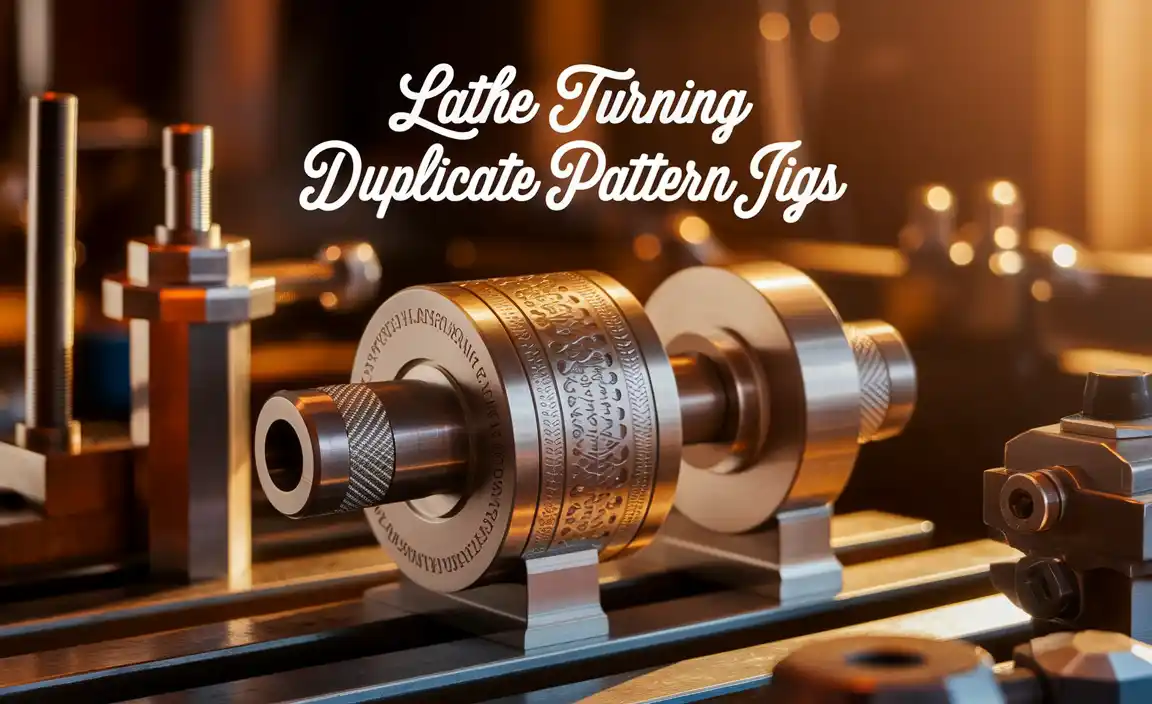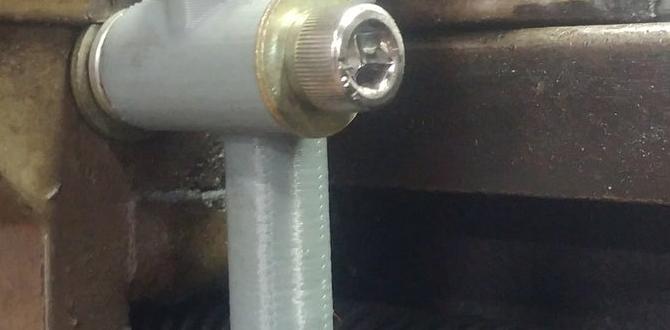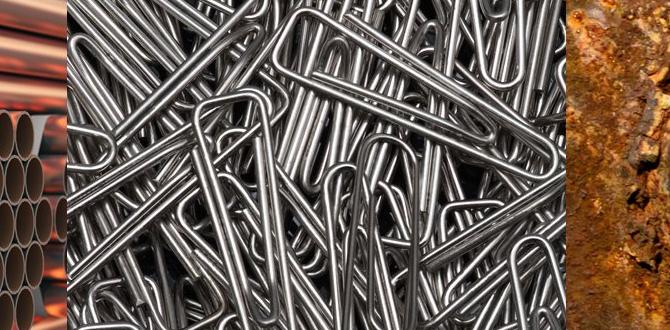Quick Summary: A TiAlN ball nose end mill is perfect for copper profiling. Its special coating handles copper’s stickiness, and the rounded tip creates smooth, detailed curves. This guide shows you how to use it effectively for clean, precise cuts every time.
Welcome to Lathe Hub! Ever tried to machine copper and ended up with a sticky mess that gums up your tools? It’s a common frustration with this beautiful, soft metal. Copper can be tricky because it’s ductile and tends to cling to cutting tools, leading to poor surface finishes and shortened tool life. But there’s a secret weapon that makes profiling copper a breeze: the TiAlN ball nose end mill!
If you’re new to milling or looking to tackle copper projects with more confidence, you’ve come to the right place. We’ll walk through exactly why this specific tool is so great for copper and how to use it to get those smooth, flowing shapes you’re after. Get ready to transform your copper machining experience from frustrating to fantastic!
Why Copper Profiling is Tricky
Copper is a fantastic material to work with for many projects, from decorative pieces to electrical components, due to its excellent conductivity and attractive appearance. However, when it comes to machining, copper presents a unique challenge. Its softness and ductility mean it has a tendency to “gum up” or “stick” to the cutting edges of standard milling tools.
When this happens, the tool doesn’t cut cleanly. Instead, it smears and deforms the copper. This can lead to:
- Rough, uneven surface finishes that require a lot of post-machining work.
- Increased cutting forces, which can put stress on your machine and the workpiece.
- Rapid tool wear or complete tool breakage as the copper builds up on the flutes.
- Difficulty in holding tight tolerances and achieving intricate details.
Traditional high-speed steel (HSS) or uncoated carbide end mills often struggle with these issues. They can work for very shallow cuts or at extremely slow speeds, but they’re not ideal for efficient and clean profiling of copper.
Introducing the TiAlN Ball Nose End Mill
This is where our star player comes in. The TiAlN ball nose end mill is specifically designed to overcome the challenges of machining softer, gummy materials like copper. Let’s break down what makes it so special.
What is TiAlN Coating?
TiAlN stands for Titanium Aluminum Nitride. It’s a PVD (Physical Vapor Deposition) coating applied to cutting tools. This coating is incredibly hard, heat-resistant, and low-friction. Here’s why it’s a game-changer for copper:
- Hardness: The coating is much harder than the copper, helping to prevent the copper from welding or sticking to the tool’s surface.
- Low Friction: The smooth, slick surface of the TiAlN coating allows chips to slide off more easily, reducing the tendency for material to build up.
- Heat Resistance: Machining generates heat. TiAlN can withstand higher temperatures than uncoated tools, which helps maintain the tool’s sharpness and extends its life, especially when cutting materials that can cause built-up edge.
- Oxidation Resistance: The aluminum content in the TiAlN coating forms a protective aluminum oxide layer at high temperatures, further enhancing heat resistance.
This combination of properties means tools coated with TiAlN perform exceptionally well in materials like aluminum, brass, and, yes, copper, where conventional tools might fail.
What is a Ball Nose End Mill?
The “ball nose” part refers to the shape of the cutting tip. Instead of a flat end like a standard end mill, a ball nose end mill has a perfectly hemispherical tip. This shape offers several advantages, particularly for profiling:
- 3D Contouring: The rounded tip allows for smooth, continuous cutting in multiple axes, making it ideal for creating complex 3D shapes, fillets, and curved surfaces without abrupt changes in direction.
- Surface Finish: The curved geometry naturally produces a smoother surface finish compared to flat-bottomed end mills when cutting curved paths.
- Corner Radii: It’s perfect for creating internal and external corner radii. With a ball nose, the radius of the internal or external corner is directly determined by the diameter of the end mill.
- Reduced Stress: The smooth transition from the cutting edge to the shank helps distribute cutting forces more evenly, reducing the risk of chipping or breakage, especially at the bottom of a cut.
Putting it Together: TiAlN + Ball Nose = Copper Profiling Perfection
When you combine a TiAlN coating with a ball nose geometry, you get a tool that’s specifically engineered to excel at profiling copper. The TiAlN coating combats the gumming and heat issues, while the ball nose shape ensures smooth, precise transitions and excellent surface finish for all your curved profiles and 3D contours. For accurate and efficient copper machining, especially when aiming for a Tialn ball nose end mill 40 degree for copper for profiling, this tool is your best bet.
Choosing the Right TiAlN Ball Nose End Mill for Copper
When you head out to buy your TiAlN ball nose end mill for copper, you’ll notice a few variations. While the TiAlN coating and ball nose shape are key, there are other factors to consider:
Diameter
The diameter of your ball nose end mill is crucial. It dictates the smallest radius you can cut internally and the largest radius you can create externally. For detailed work, smaller diameters are often preferred. For general profiling, a mid-range diameter might be more versatile. Common diameters range from 1/16″ (1.5mm) up to 1″ (25mm) or more. Your choice depends on the scale and detail of your intended projects.
Number of Flutes
Flutes are the spiral grooves in the cutting tool. For softer materials like copper, you generally want fewer flutes.
- 2 Flutes: Excellent for softer materials like copper and aluminum. They provide more chip clearance, which is vital for preventing the gummy material from packing up in the flutes. This helps maintain a clean cut and reduces the heat generated.
- 3 or 4 Flutes: These are typically better for harder materials like steels, where chip load per tooth is more important, and you don’t have the same gumming issues. Using a 4-flute end mill in copper can lead to chip packing and poor results.
So, for copper profiling, a 2-flute TiAlN ball nose end mill is usually the ideal choice.
Coating Thickness and Quality
Not all TiAlN coatings are created equal. Higher quality coatings are applied more uniformly and have excellent adhesion to the tool substrate. While you can’t always tell this from a catalog, reputable tool manufacturers will produce better, more durable coatings.
Helix Angle
The helix angle refers to the angle of the flutes around the tool’s body. For copper, a lower helix angle (often around 30 degrees) is sometimes recommended because it can provide a sharper cutting edge. However, many general-purpose ball nose end mills for aluminum and copper come with a standard helix angle (e.g., 30-45 degrees) that works very well. Some specialized tools might even have an “uncoated” or zero-degree helix angle on the very tip for a sharper finish on the deepest part of the cut, though this is less common on standard TiAlN coated tools.
Substrate Material
Most modern end mills, especially those with advanced coatings like TiAlN, are made from solid carbide. Carbide offers superior hardness and rigidity compared to High-Speed Steel (HSS), allowing for higher cutting speeds and better accuracy. For demanding tasks like profiling, solid carbide is definitely the way to go.
The “40 Degree” Specification
The mention of “40 degree for copper” in some product descriptions might refer to the effective relief angle or a specific geometric feature designed for copper’s unique machinability. Sometimes, a slightly different geometry can optimize chip evacuation and cutting action for a particular material. If you see a tool specifically marketed as “40 degree for copper,” it’s likely been engineered with this in mind, focusing on providing excellent performance for this specific application. However, a good quality 2-flute TiAlN ball nose end mill with a standard 30-degree helix angle will likely perform excellently as well.
Recommendation: For beginners, opt for a 2-flute, solid carbide, TiAlN coated ball nose end mill. The diameter will depend on your project needs, but a common size like 1/4″ (6mm) or 1/2″ (12mm) is a good starting point.
Setting Up Your Machine for Copper Profiling
Once you have your TiAlN ball nose end mill, the next step is setting up your milling machine for the job. Proper setup is just as critical as the tool itself for achieving great results safely.
1. Securely Mount the Workpiece
Copper is soft, which means it can be easily deformed or moved during machining. Ensure your workpiece is held as rigidly as possible. This might involve:
- Using a vise with soft jaws to prevent marring the copper surface.
- Clamping it directly to the mill table using T-nuts and clamps, ensuring the clamps don’t interfere with the cutting path.
- Using double-sided tape or fixturing specifically designed for non-ferrous materials if the part is thin or delicate.
A wobbling or shifting workpiece will lead to inconsistent cuts and can be very dangerous.
2. Choose Appropriate Cutting Parameters
This is where things get interesting. While TiAlN helps, copper still needs careful handling. These are general guidelines, and you may need to adjust based on your specific machine, tool rigidity, and the exact alloy of copper.
Spindle Speed (RPM)
For softer materials like copper, you can use relatively high spindle speeds. This helps the tool cut “cleanly” rather than smearing. A good starting point for solid carbide tools in copper is often between 5,000 and 20,000 RPM, depending on the tool diameter and your machine’s capability. Smaller diameter end mills generally require higher RPMs.
Feed Rate
The feed rate is how fast the tool moves through the material. For copper, you want a feed rate that allows each flute to take a reasonable chip. Too slow, and you risk rubbing and heat buildup; too fast, and you risk chatter or tool breakage. A good starting point for a 1/4″ (6mm) diameter 2-flute end mill might be around 15-30 inches per minute (IPM) or 400-800 mm per minute. Chip thinning is a concept where you might increase the feed rate and decrease the depth of cut to maintain a thin chip, which is very effective in copper.
Depth of Cut (DOC)
Since copper is soft, you can often take relatively deep cuts radially (how much of the tool’s diameter is engaged) and shallower cuts axially (how deep the tool goes into the material). For profiling, you’ll often use a shallow axial DOC and a radial engagement that can vary depending on the complexity of the profile. Try to keep axial DOC around 0.010″ – 0.050″ (0.25mm – 1.25mm) for finishing passes, and potentially deeper for roughing if your setup is rigid enough. Many CAM software packages have adaptive clearing strategies that manage depth and radial engagement efficiently.
Coolant/Lubrication
While TiAlN helps, proper lubrication can significantly improve surface finish and tool life. For copper, a flood coolant system is ideal. If that’s not available, a mist coolant system or even a specialized cutting fluid or spray (like WD-40 or a dedicated aluminum/copper cutting fluid) applied judiciously can make a big difference. The goal is to keep the cutting zone cool and lubricated to prevent chip welding.
3. Fixturing and Workholding Considerations Table
Here’s a quick reference table for common workholding methods when machining copper:
| Workholding Method | Pros | Cons | Best For |
|---|---|---|---|
| Vise with Soft Jaws | Simple, secure hold, protects surface finish | Can mar copper if not padded properly, clamping force can deform thin parts | General machining, thicker stock, parts where surface finish is important on one side |
| Clamps and T-Nuts | Directly secures part to table, allows access to most surfaces | Requires precise placement to avoid interference, can distort thin or delicate parts due to clamping pressure | Larger parts, or when vise access is an issue, or when using fixtures |
| Double-Sided Tape / Adhesive Fixturing | Excellent for thin or delicate parts, provides full access to all surfaces, minimal distortion from clamping force | Requires a very rigid machine to avoid vibration, tape can be hard to remove, requires a flat mating surface | Sheet copper, intricate thin parts, high-detail work where no clamping marks are acceptable |
| Fixtures (Custom or Commercial) | Highly repeatable, provides optimal support and alignment, can be designed for specific operations | Can be expensive or time-consuming to create | Production runs, high-precision tasks, complex multi-step operations |
4. Pre-Drilling and Tool Access
For profiling, you often need to create a starting hole for the end mill to plunge into, especially if you’re not starting from an edge. Use a drill bit or a center drill to create a small pilot hole. Ensure that your tool path in your CAM software accounts for this plunge. Also, make sure your tool is long enough and your machine’s Z-axis has enough travel to reach the bottom of your cuts without crashing.
The Machining Process: Step-by-Step Profiling
Now that your machine is set up and your tool is ready, let’s walk through the actual process of profiling copper using your TiAlN ball nose end mill.
Step 1: CAM Programming (or Manual Programming)
For anything beyond simple straight lines on a manual mill, you’ll likely use Computer-Aided Manufacturing (CAM) software. This software takes your 3D model of the part and generates the toolpaths for the milling machine.
- Define the Tool: Accurately input the diameter, number of flutes (2 for copper!), and any other relevant parameters of your TiAlN ball nose end mill into the software.
- Select Operation: Choose a profiling or contouring operation. For ball nose end mills, 3D contouring strategies are often best as they allow for smooth, continuous path generation.
- Set Cutting Parameters: Enter your calculated speeds, feeds, and depths of cut. You’ll likely define both roughing (faster, deeper cuts) and finishing (slower, shallower cuts for accuracy and surface finish) passes.
- Specify Stepover and Stepdown:
- Stepover (Radial): This is how much the tool moves sideways on each pass. For finishing, a small stepover (e.g., 5-10% of tool diameter) is good for a smooth surface. For roughing, you can use a larger stepover.
- Stepdown (Axial): This is how much the tool advances deeper into the material on each full-width pass. As mentioned, shallower stepdowns are better for finishing.
- Roughening and Finishing Passes: It’s good practice to use a separate roughing pass to remove the bulk of the material along the profile, followed by a finishing pass with a smaller stepdown and potentially a slower feed rate for the best surface quality.
- Toolpath Generation: The software will then generate the G-code (the machine’s instructions).
For manual milling, you’ll be setting up your machine’s controls and moving the axes by hand or via DROs (Digital Readouts) to follow your intended path, which requires a good understanding of geometry and careful measurement.
Step 2: Tool Path Verification
Before you run the actual cutting, always verify your toolpath. Most CAM software allows you to simulate the cutting process on your computer. Watch the simulation closely to:
- Ensure there are no collisions between the tool, workpiece, or machine components.
- Check that the tool is removing material as expected.
- Confirm that your desired features are being created correctly.
This virtual step is a huge time and tool saver!
Step 3: Setting Up the Machine Origin (Zero Point)
On your milling machine, you need to tell it where the “$0,0,0$” point of your program is located in the real world. This is usually done by touching off the tool to the workpiece surface.
For most profiling operations:
- X and Y origin: Set this








